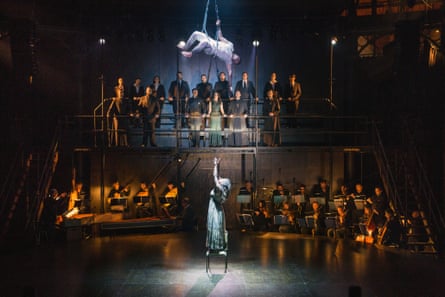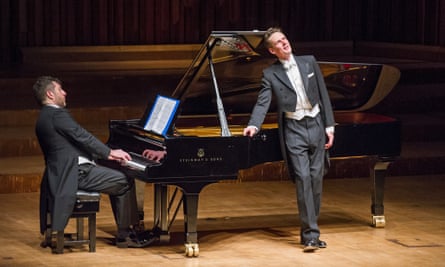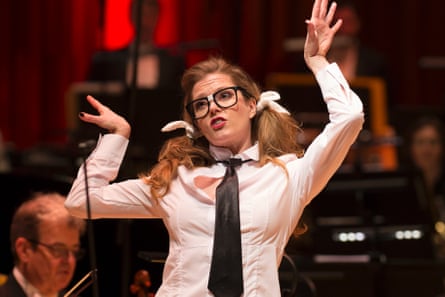
The imperative is simple, the consequences fatal. Lot’s wife turns to salt. Orpheus loses his wife to perpetual damnation. From the Bible to Ovid, from Rilke to Salman Rushdie, from musical to film to video game, the instruction “don’t look back” has proved one of humanity’s most evocative and fertile refrains. It is the impetus for Monteverdi’s 1607 Orfeo, the first operatic masterpiece, which takes the sorrowing poet-musician of Greek myth as its subject.
The Royal Opera’s new production opens with a Christian metaphor: a pietà of Euridice holding her beloved’s body limp in her arms. It ends terrifyingly with Orfeo dangling aloft from a dodgy- looking harness. Will he make it up to heaven to meet his father, the god Apollo, or will he tumble downwards to Hades? Every muscle in his grieving body urges him back to his dead wife.
This highly acrobatic, not to say ecumenical, staging at the Roundhouse is the company’s first production of Orfeo. It is, too, a first collaboration with the north London venue and a first opera staging for Michael Boyd, former artistic director of the RSC. The usual ROH chorus and orchestra have been replaced by an ensemble of nine postgraduate singers from Guildhall School of Music and Drama and musicians from the Early Opera Company.
So all was different, risky and enterprising, a novel way to try out baroque opera and a lively follow-up to the Royal Opera’s excursion last year to the Sam Wanamaker Playhouse for Cavalli’s L’Ormindo (revived next month). Not everyone will think a former railway engine shed, part amphitheatre, part hangar, the best choice for a work as graceful in its potency as Orfeo. Voices were subtly and effectively amplified. Only a stickler should object.
Performance is in the round, extending beyond the discus stage to a balcony for the chorus and a steep walkway used once spectacularly – when a chain of people tug Euridice to her death – but otherwise merely requiring much neck craning for some. In Tom Piper’s simple designs, with lighting by Jean Kalman, there were few props beyond green and red streamers, doubling as trees, blood, serpent. Clothing is subfusc or boiler suits, except for the lovers, who wear marital white. Dancers, aged 11 to 21, from East London Dance, tumbled and rolled and slid and leapfrogged enthusiastically – especially endearing, if that’s the word, as the river Styx.
In the title role, the compelling Transylvanian baritone Gyula Orendt elevated the entire enterprise to a special and memorable level. With a slight accent to his English, which charmed rather than interfered with comprehension, he plundered every aspect of Monteverdi’s exploration of love’s pain. His big aria, Possente spirto, with its instrumental interjections and echoes, in which he bewitches the ferryman Charon to sleep, was expressive and pitiful.
Action was at times hard to decipher, but the careful patterning and mirroring in Boyd’s direction offered some clarity. So too did the poet Don Paterson’s tender English translation. After a frustrating first half when all seemed somewhat haphazard, the show grew more coherent until any initial resistance melted. Mary Bevan’s compassion and vitality made for an ideal Euridice. Rachel Kelly (Proserpina), Susanna Hurrell (Nymph) and Callum Thorpe (Pluto) all shone, with Susan Bickley tender and affecting as Messenger and James Platt formidable as Charon. Each of the ensemble cast deserved their cheers.
Christopher Moulds, conducting from harpsichord, regal and organ, made keen contrast of the various divisions of the score – strings, brass and plucked instruments. The continuo playing was sinewy and sensuous, ornaments rarely exaggerated. There was some unsteady intonation from the strings, and rhythms were occasionally woolly across the ensemble, but the acoustic may not have helped. Lutes and harp were fiery yet delicate. Monteverdi’s genius worked its magic.
Orfeo mourns the agony of loss. Winterreise grieves for loneliness itself. This cycle of 24 songs, which Schubert wrote near the end of his short life, scours heart and soul to scrape every last shred of desolation and express it in music. If Schubert’s friends were shocked at first hearing the work, its impact today is conceivably yet greater. We can know it more intimately. It is performed, discussed, studied, recorded. Singers and pianists perform it with a polish and refinement worlds away from Schubert’s own rough-and-ready accounts.

The tenor Ian Bostridge has, in every sense, lived with the cycle since he first performed it 30 years ago – the equivalent of Schubert’s entire lifetime minus one year. Now Bostridge has written a richly eclectic book – Schubert’s Winter Journey: Anatomy of an Obsession – and completed an international tour of the songs with the composer-pianist Thomas Adès. The pair gave a remarkable, sell-out performance at the Barbican on Monday, the anguish and musical daring of which has discomfited me all week. The work was written in two parts, the first of which has more obvious variety, the light and shade easier to convey.
The second takes us to uneasy psychological realms, the closest music comes to a portrayal of what can only be deep depression. Adès’s playing, always dazzling in invention but not showy, conjured a world parched of colour, distilled into a seamless, distant reverie of the kind found in Schubert’s late piano sonatas. Bostridge, in contrast, showed all the traveller’s raw pain in the winter of his life. The approach to each song, challenging and surprising, is the defining fascination of the book.

Bostridge takes 500 pages. I have about five sentences left, which I must use to say: happy birthday Simon Rattle, who is 60 tomorrow. He conducted the London Symphony Orchestra on Thursday in Stravinsky’s The Rite of Spring with a zest, fury and joy that stirred a thrilling sense of renewal in these dark days. In this, and in Webern’s haunting Six Pieces for Orchestra, the LSO’s playing was at once meticulous and, as required, explosive. The amazing Canadian soprano Barbara Hannigan – who else can, or would, skip on to the Barbican stage in high heels and white pop socks? – was hilarious and brilliant in Ligeti’s Mysteries of the Macabre. Don’t miss her: she’s back soon. Rattle is here too for a joint Barbican-Southbank extravaganza. May his concerts never be anything but extraordinary. So far, no sign.
Star ratings (out of 5)
Orfeo ****
Winterreise ****
LSO/Rattle *****
Comments (…)
Sign in or create your Guardian account to join the discussion